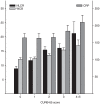The neutrophil-lymphocyte count ratio in patients with community-acquired pneumonia
- PMID: 23049706
- PMCID: PMC3462173
- DOI: 10.1371/journal.pone.0046561
The neutrophil-lymphocyte count ratio in patients with community-acquired pneumonia
Abstract
Study objective: The neutrophil-lymphocyte count ratio (NLCR) has been identified as a predictor of bacteremia in medical emergencies. The aim of this study was to investigate the value of the NLCR in patients with community-acquired pneumonia (CAP).
Methods and results: Consecutive adult patients were prospectively studied. Pneumonia severity (CURB-65 score), clinical characteristics, complications and outcomes were related to the NLCR and compared with C-reactive protein (CRP), neutrophil count, white blood cell (WBC) count. The study cohort consisted of 395 patients diagnosed with CAP. The mean age of the patients was 63.4 ± 16.0 years. 87.6% (346/395) of the patients required hospital admission, 7.8% (31/395) patients were admitted to the Intensive Care Unit (ICU) and 5.8% (23/395) patients of the study cohort died. The NLCR was increased in all patients, predicted adverse medical outcome and consistently increased as the CURB-65 score advanced. NLCR levels (mean ± SD) were significantly higher in non-survivors (23.3 ± 16.8) than in survivors (13.0 ± 11.4). The receiver-operating characteristic (ROC) curve for NLCR predicting mortality showed an area under the curve (AUC) of 0.701. This was better than the AUC for the neutrophil count, WBC count, lymphocyte count and CRP level (0.681, 0.672, 0.630 and 0.565, respectively).
Conclusion: Admission NLCR at the emergency department predicts severity and outcome of CAP with a higher prognostic accuracy as compared with traditional infection markers.
Conflict of interest statement
Figures


References
-
- Garau J, Baquero F, Perez-Trallero E, Perez JL, Martin-Sanchez AM, et al. (2008) Factors impacting on length of stay and mortality of community-acquired pneumonia. Clin Microbiol Infect 14: 322–329. - PubMed
-
- Polverino E, Torres Marti A (2011) Community-acquired pneumonia. Minerva Anestesiol 77: 196–211. - PubMed
-
- Fine MJ, Stone RA, Singer DE, Coley CM, Marrie TJ, et al. (1999) Processes and outcomes of care for patients with community-acquired pneumonia: results from the Pneumonia Patient Outcomes Research Team (PORT) cohort study. Arch Intern Med 159: 970–980. - PubMed
-
- Christ-Crain M, Muller B (2007) Biomarkers in respiratory tract infections: diagnostic guides to antibiotic prescription, prognostic markers and mediators. Eur Respir J 30: 556–573. - PubMed
MeSH terms
Substances
LinkOut - more resources
Full Text Sources
Medical
Research Materials
Miscellaneous

